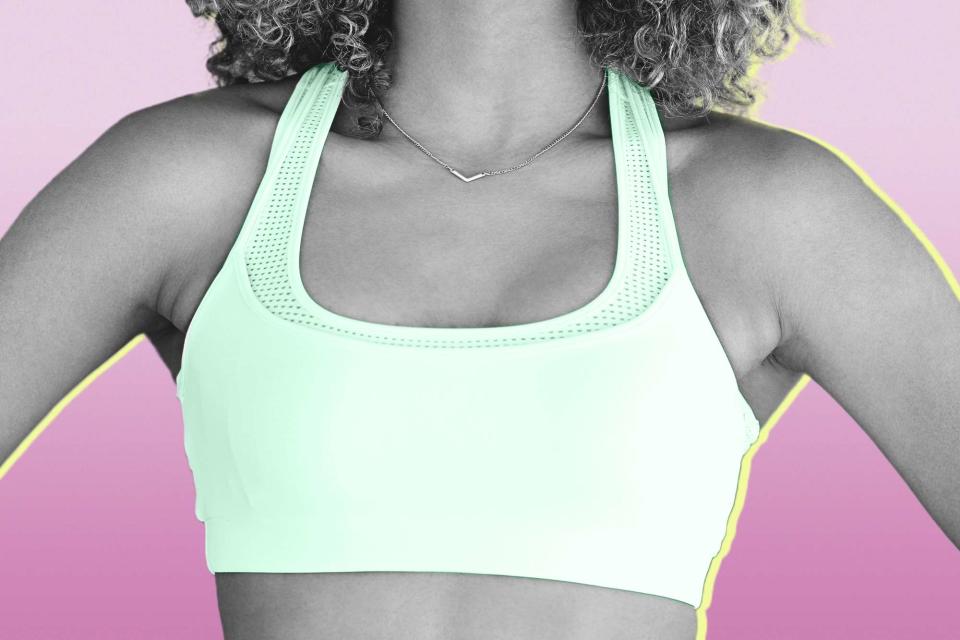High Levels of BPA Were Found In Sports Bras and Athletic Shirts from Popular Brands
Here's what you need to know.

When shopping for water bottles, food storage containers, and cookware, many check the label to make sure these items are BPA-free. But new research shows you might want to pay closer attention to BPA levels in other goods, including workout clothes.
The Center for Environmental Health (CEH) sent legal notices to 14 athletic wear brands after testing revealed some of their clothing items — sports bras and athletic shirts — could be exposing wearers to high levels of BPA, it said last week in a press release. Specifically, the clothes may expose people to up to 22 times the safe limit of BPA, in accordance with California law. The brands notified include popular names such as Nike, PINK, Athleta, The North Face, All in Motion, Brooks, Mizuno, Reebok, New Balance, FILA, and Asics. They have 60 days to work with the agency to fix the violations. If the violations remain unremedied, CEH will file a complaint.
ICYDK, BPA (bisphenol A) is a chemical used to make plastics and line some metal products, such as food cans and bottle tops. Companies often boast their products are BPA-free, as the chemical is known to be a hormone disruptor, with research suggesting exposure to BPA could cause health effects in fetuses, infants, and children, as well as increased risk of blood pressure, type 2 diabetes, and cardiovascular disease, according to the Mayo Clinic.
Low levels of BPA exposure may occur if small amounts of the chemical migrate from packaging to foods or beverages, explains the Food and Drug Administration (FDA). However, approved uses of BPA in food containers and packaging are safe, reports the FDA, noting studies from the FDA's National Center for Toxicology Research haven't found an effect from low-dose BPA exposure.
Exposure isn't limited to ingestion. "Studies have shown that BPA can be absorbed through skin and end up in the bloodstream after handling receipt paper for seconds or a few minutes at a time," said Kaya Allan Sugerman, Illegal Toxic Threats program director at CEH, in the organization's release. "Sports bras and athletic shirts are worn for hours at a time, and you are meant to sweat in them, so it is concerning to be finding such high levels of BPA in our clothing," she continued. “Sweat acts as a solvent and has been found to pull contaminants out of clothing," adds Jimena Díaz Leiva, Ph.D., Science Director at CEH.
BPA mimics estrogen and can interrupt the body's normal methods of functioning, including reproduction and metabolism along with growth and development, according to the CEH.
Exposure to BPA is especially concerning for people who are pregnant. A fetus is more sensitive to BPA than an adult, and the consequences of exposure can "last a lifetime," Hugh Taylor, M.D., chair of the department of obstetrics and gynecology and reproductive sciences at Yale University and chief of obstetrics and gynecology at Yale-New Haven Hospital who has studied BPA, tells Shape.
Consequences may include behavioral changes, fertility issues, and risk of estrogen-sensitive diseases, such as breast cancer and endometriosis, he adds. "If the clothing is releasing BPA, this is something that is quite concerning and surprising and something that manufacturers should know to avoid."
:
According to Proposition 65, California's Safe Drinking Water and Toxic Enforcement Act of 1986, the state is required to publish a list of chemicals (including BPA) that are known to cause reproductive harm and cancer and to let residents know about exposures. The level of BPA allowed "via skin exposure is three micrograms per day" in the state, reported CNN earlier this week.
While the CEH cites California law in its recent report, the legal notices sent to identified brands go past the state's borders. "While we litigate under Prop 65, California's Clean Drinking Water and Toxics Enforcement Act, the repercussions of our settlements extend beyond California as it is most often economically infeasible for companies to reformulate for just the California market," Emily DiFrisco, director of communications for CEH, told Shape in an emailed statement. "Our legal action has been successful in pushing entire industries to remove certain chemicals from products, [such as] children's candy or toys. These cases not only serve to protect California consumers but also consumers throughout the country."
So, should you frantically go through your closet and pitch your sports bras and workout shirts? "This [BPA] does clear the system pretty quickly," says Dr. Taylor. "So, it's not something you have to worry about accumulating [over time]. Short exposure, shorter and briefer exposure, is probably better," he adds, noting that it's the constant exposure to BPA that's concerning. With this in mind, consider changing out of your sports bra quickly post workout.
Still, it might be a good idea to check to see if your favorite workout gear contains BPA, suggests Dr. Taylor, who advises people contact manufacturers directly. And if you find out a sports bra or top you own does contain high levels of BPA, toss it, says Dr. Taylor. Additionally, try keeping the amount of time you're wearing your athletic clothing to a minimum, he and the CEH suggest.
"We're exposed to Bisphenol A from multiple sources constantly every day," says Dr. Taylor, noting it's about balance. The goal, bottom line, is to minimize exposure, he adds.
false

